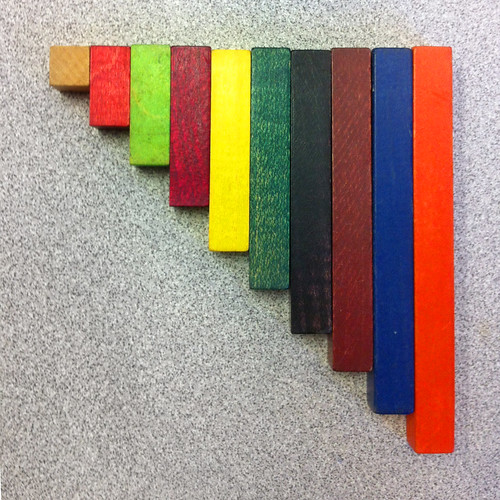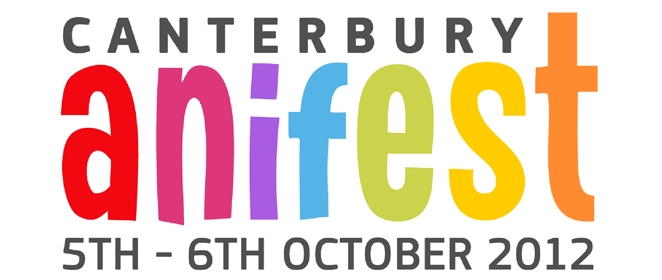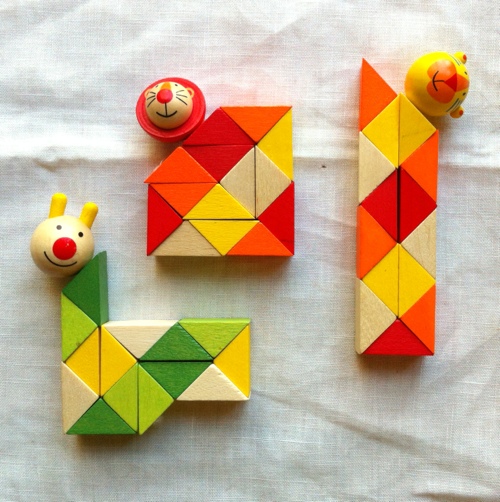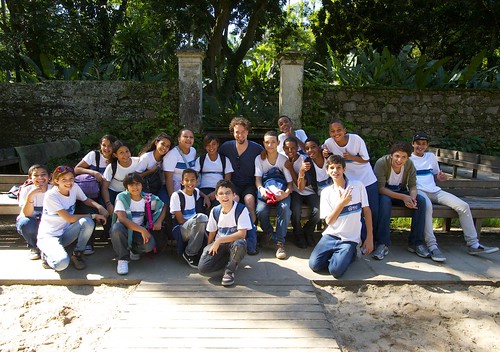Why do coffee stains always have a dark ring around the edge? It’s because the water’s surface is curved: it evaporates more quickly near the edges, causing it to flow outward from the middle, carrying coffee particles with it. We cited some early research demonstrating this effect in our 1997 watercolor paper, but now there’s video that actually shows the process happening at a microscopic scale. (Thanks Eric for the link!)
A clue from the distant past!
While looking at a possible kindergarten for our 4-year-old, I stumbled on a bin full of these colored wooden blocks in one of the classrooms. I remember these blocks from my classroom in 2nd grade. The shortest stick is a cube, and the longest is ten cubes. You can use them to teach arithmetic, by putting them together end to end and seeing how they line up, arranging them into rectangles, and so on.
But what caught my eye was something very different: according to my synesthesia, the first three blocks are all exactly the right colors. In particular, the unit block, being unpainted wood, perfectly captures the tendency of the number 1 to hover between white and yellow in my mind. I have vivid memories of playing with these blocks, assembling them into shapes, in that 2nd grade classroom. Could this be the origin of my synesthetic map? It feels too right to be a total coincidence. And yet, none of the colors from 4 through 10 match my mappings at all.
Apparently the blocks are called Cuisenaire Rods (or rechenstäbchen) and their colors have not changed substantially since the 1950’s. This means that thousands of synesthetic children may be exposed to these blocks during their formative years. I wonder if anyone else had their colors influenced in this way?
Exquisite corpse fold-in pixel art!
I’ve been a fan of Ed Stastny’s work since the early days of the web, when SITO.org clued me in to the awesome possibilities of massively collaborative, software-guided web art projects. Gridcosm was surprising, disturbing, inspiring, and highly addictive. It was also a big influence on me personally: without that shining example of the weird things a group of total strangers can do together, I may never have come up with the idea to put Graffiti Archaeology on the web.
Now Ed has a wonderful new project in the works, and he needs your help to make it happen. Yono mashes up 8-bit pixel art, the exquisite corpse surrealist parlor game and Mad Magazine’s fold-ins. It picks up where Gridcosm left off, but it takes full advantage of the magical powers of today’s Internet: it will come with its own pixel art painting tool, and will be designed to work on pretty much any device, so the barriers to participation will be far lower, meaning everyone can play.
He’s offering some very cool thank-you gifts on his Kickstarter, and there are only 9 days left! So if this is something you’d like to support, jump in and help, will you?
Upcoming talk: Canterbury Anifest
Later this fall, I’ll be speaking at an animation festival in England. Canterbury Anifest is the weekend of October 5-6, and my talk will be Saturday morning at 9am. If you’re in the UK and yearning for nerdy discussion and pretty pictures, stop by!
My talk will be a variation of the “Animator as Designer” talk I gave at Animasyros last year. If you’ve already seen that talk, you should probably just sleep late and have a long breakfast. You look so tired, so skinny! But do come after lunch to see the other presenters from Aardman, Double Negative, and Pixar. Or watch a great selection of animated shorts. Or do one of the hands-on animation workshops. Really, it’s hard to go wrong. The whole event should be a lot of fun.
You can read more details about the event and the other speakers over at the Canterbury Anifest blog.
Time and its impact on fun
I like to play word games. Scrabble and Boggle are two of my childhood favorites, and nowadays I play Zynga’s “With Friends” versions of both games on my phone. (If you want to play me, look for “cassidyjcurtis” or “otherthings”!)
Both games are about scrambling letters up into words, and both make heavy use of the anagram-loving part of me. But I’ve noticed that the two games produce very different mental states. The reason has to do with how they make use of time.
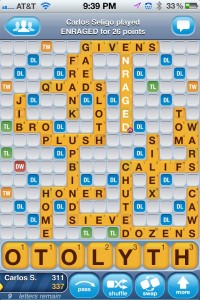
In Scrabble, there’s no time limit. You’re free to take as long as you want to play a word, but you can’t take it back once you’ve played it. The effect that has, on me anyway, is to make me an optimizer. I try to find the best possible word for the given moment, taking everything into account: the score, the state of the board, the consonant-to-vowel balance of my rack, how many letters are left, and so on. It’s a complex mix of concerns, and sometimes I just can’t see any option that’s clearly the best. But because I know my vocabulary is limited, I always suspect that a better word is out there that I’m just not seeing. When this happens, I get stuck, unable to play, effectively paralyzed. So Scrabble as a game makes me happy when I’m doing well, and miserable when I’m not. It’s not so much about the score of the game, as whether I’m measuring up to some abstract ideal of the perfect player. What a headache!
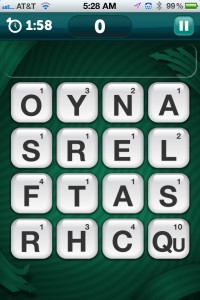
In Boggle, there’s a hard time limit, and the goal is to find as many words as you can in that time. Some words are worth more than others, of course, but it’s usually better to find lots of small words than a handful of huge ones. So when the clock starts ticking, I just start finding words as fast as I can, with no time wasted on judging good from better. And what I find tends to happen is that small words lead to bigger words, in a stream-of-consciousness kind of way that’s energetic but not stressful, and just a lot of fun. I only pop up to look at the big picture when the vein I’m mining runs dry. And before I know it, time is up, and I’ve finished my turn exhilarated by the effort. Sometimes I win, and sometimes I lose, but I always enjoy the game. And enjoying the game, feeling that state of flow and fun, directly impacts my ability to play it well.
What this has to do with animation, or any complex creative work, should be pretty clear. You can approach a new shot in either way: give yourself all the time in the world to find the best possible idea, or give yourself a hard time limit (to accomplish some part of the job) and just start exploring, and then see what you’ve got when your time runs out.
I’ve experimented with the size of the task and the length of the time limit. And what I’ve noticed surprised me: the shorter the time limit, the more fun I have. And more fun leads to better quality work. I do still feel the urge to optimize sometimes. But on my best days, I’m too busy playing to notice.
The Limits of Color Coding
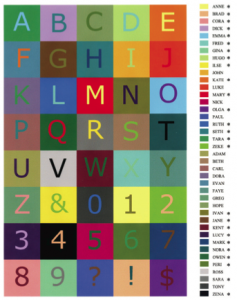
I’m a big fan of color coding. I use it to help me wrap my head around complex tasks, like computer animation. I’m also a pretty harsh judge of color coding schemes, especially for transit systems. Growing up in New York spoiled me for good in that regard: the subway there has its flaws, but color is not one of them. Having synaesthesia also makes me tend to organize names by color in my head (but usually only in my head, since nobody else shares my personal alphabet of colors.)
One of the problems with any color coding scheme is that the more things you need to code, the harder it gets to choose distinct colors. But where exactly is the limit? That’s the subject of this interesting paper, A Colour Alphabet and the Limits of Colour Coding (PDF) by Paul Green-Armytage. The lengths these folks went to to understand the problem are impressive. The paper also has great sentences like “Ivan is the colour of the letter G but four people saw it as Adam.” (Thanks to Mike K. for the link!)
Painterly rendering in your pocket.
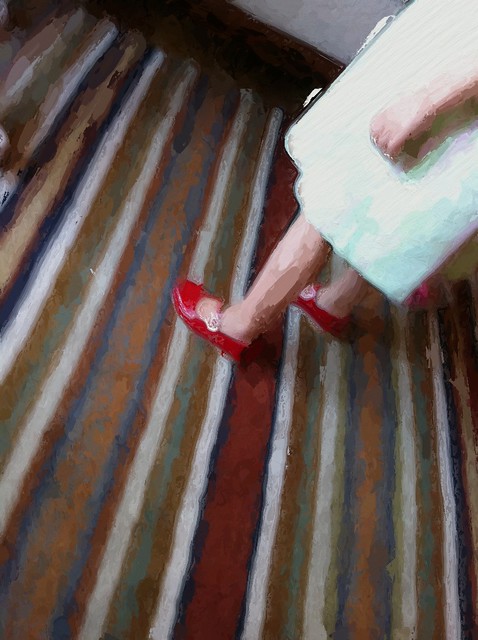
My friends Dan Wexler and Gilles Dezeustre have just released a new app for your iPhone/iPad. It’s called Glaze. It’s a painterly rendering filter for your photos, and it’s really cool. It’s based on the traditional brushstroke-based model pioneered by folks like Paul Haeberli, Pete Litwinowicz and Aaron Hertzmann, but it adds some neat new twists: face detection to guarantee that eyes and other important features come out with the right amount of detail; a genetic algorithm for mutating and doing artificial selection on painting styles; and a really slick iOS interface that makes all of the above completely effortless and transparent. It also runs blazingly fast, considering all the work that must be going on under the hood. They’ll be giving a talk about the details at SIGGRAPH next week. (Here’s an abstract of their talk… wish I could go!)
What I find the app does best, so far, is to turn my garbage photos into beautiful art. This, for example, is a picture my thumb took by accident as I was putting away my phone. The original photo was blurry, out of focus, and weirdly composed. But the painting’s handmade feeling makes your eye linger on the details, and the results are just lovely. (Everyone’s Instagram is about to get a lot prettier!)
Interesting folding toys
Our friends in São Paulo gave our daughter these cute wooden folding toys. They’ve got elastic running through the middle, so you can twist the pieces around and make different shapes. After playing with them for a while, I noticed that they have an interesting mathematical property: when folded into any flat shape, any two triangles that meet are always the same color, forming a grid of diamonds (or squares, depending on your point of view.) I can’t help wondering why this is. It has something to do with the repeating pattern of four colors, obviously, but what?
Madagascar fans at the Jardim Botanico
We were taking a stroll through Rio de Janeiro’s gorgeous botanical gardens, when we ran into two big groups of kids on field trips from schools in the area. My lovely wife (and now, apparently, publicist) struck up a conversation with some of the boys, and let slip what I do for a living, and that I knew how to draw Alex the Lion. Next thing I knew, everyone had their cell phones out to take pictures, and I spent about a half hour talking with the kids, and drawing Alex, Marty, Skipper and other characters. They all were apparently big fans of the Madagascar series. Everyone was super excited. I even got one of the boys to draw something in my sketchbook. He drew a lovely princess.
When you’re in the movie business it’s so easy to get swept up in crtitical reviews and statistics, and obsess over the opportunities you’ve missed where you could have made this scene or that one work just a little better. It can make you pretty grumpy. So it’s pretty nice to get a reality check once in a while, and realize that there are kids, all over the world, who simply love what we do.
Animating with a wrecking ball
Any professional animator can tell you that animating well is only half of the job. The other half is being able to work well with others: directors, supervisors, your fellow animators, other departments that depend on you, etc.
One of the biggest struggles I see animators face is how to handle changes. Because animation is so time-consuming, it’s easy to think of your work like it’s a kind of architecture: first you must lay down a strong foundation, and then you can start building walls, etc., and finally put on that sweet paint job that makes it look awesome.
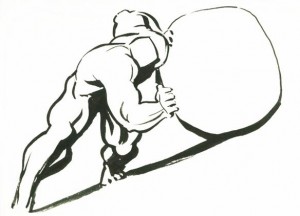
This view is certainly true at a technical level: once the idea of the shot is clear in your mind, the process of blocking, breaking down, and polishing does have a kind of one-directional feel to it. It can be hard to go back and adjust your blocking after you’re well along in the polishing process. So, if for any reason you get notes from your director that change your blocking significantly, it can feel pretty bad.
But if you think this technical process is what your work is about, you’re completely missing the big picture.
Your real job as an animator is to find and execute the best possible performance. The performance is not made of keyframes and curves, any more than it’s made of bricks and concrete. It’s made of ideas. That is what you’re here to find. The part of animation that’s like building a house? That’s just the execution of the ideas. If you’re executing the wrong ideas, it’s like building your house in the middle of the road. No matter how good it looks, it’s not going to be a nice place to live.
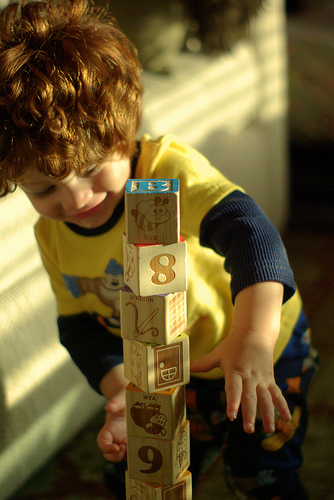
So here’s a trick to help you deal with changes: learn to love destroying your own work. Genuinely enjoy it. Relish it. Specifically: you have to enjoy the process of destroying as much as you enjoy creating. Make it fun. Make it something you’ll look forward to, if you’re given the chance to do it.
Remember when you were a little kid? Did you ever make a huge tower of blocks, just so you could knock it down and make a huge crash? Remember how you wanted to do it over and over again? Destruction can be delicious fun.
So before you bring your shot in for review, take a moment to contemplate its utter demolition. Step back and take a hard look at your shot, and ask yourself: if I had to smash this to bits, how would I do it? Which parts would I smash at first? If I had to start again, what would I do differently? Savor that idea for a moment. And bring it with you to your review.
This is your wrecking ball. If the director asks you to make a major change, it just means you’ve got permission to use it. And when you do, you can do it with gusto.

